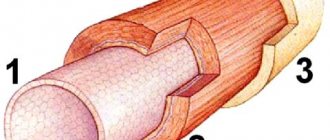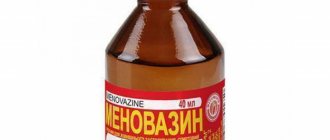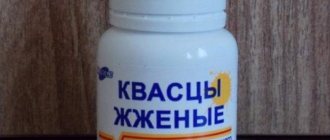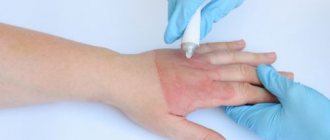Pharmacodynamics and pharmacokinetics
The effect of the drug is due to two active components included in its composition.
Belladonna extract contains atropine group alkaloids – hyoscyamide, apoatropine and scopolamine. These substances tend to reduce the tone of smooth muscles and the gastrointestinal tract (spasmolytic effect) and reduce the secretion of the pancreas, salivary, gastric, bronchial and sweat glands (antisecretory effect).
Benzocaine is a strong analgesic - anesthesin . It has an analgesic effect on the mucous membrane of the stomach and esophagus.
Characteristics of the drug
Bellasthesin is available only in tablet form. One piece contains two main active ingredients:
- 300 mg benzocaine;
- 15 mg belladonna extract (belladonna leaf extract).
Potato starch, talc, calcium stearate, colloidal silicon dioxide, sodium carboxymethyl starch are present as excipients.
The tablets have a flat oval shape and a score. The color is uneven, predominantly brown, with patches of light and dark shades.
Packaged in plates with cells of 10 pieces. Depending on the manufacturer, it may be sold in a box with an annotation or without a box.
Contraindications
Taking the drug is contraindicated:
- with hypersensitivity ( allergy ) to belladonna , benzocaine , other amide anesthetics and drug components;
- for glaucoma ;
- myasthenia gravis;
- thyrotoxicosis;
- for arrhythmia , heart failure , tachycardia , ischemia , mitral stenosis , high blood pressure;
- with hyperthermic syndrome ;
- acute bleeding;
- with a tendency to urinary retention.
Side effects
Possible:
- dry mouth, impaired sense of taste, atony , decreased tone of the gallbladder, feeling of thirst, constipation ;
- facial flushing, palpitations, myocardial ischemia , arrhythmia , hot flashes ;
- fear of bright light, increased intraocular pressure , dilated pupils, problems with accommodation ;
- urticaria , skin rashes, hyperemia ;
- dysarthria , dry skin;
- urinary retention;
- headaches and loss of consciousness;
- formation of viscous sputum, which is difficult to expectorate;
- anaphylactic shock.
If the above reactions occur, you should stop taking the drug and consult a specialist.
Overdose
The most common symptoms of overdose are: nausea , tachycardia , irritability, overexcitation, tremor , insomnia , hallucinations , depression of the central nervous system , nausea, drowsiness .
In case of overdose, the stomach should be lavaged, symptomatic therapy should be performed, and cholinomimetics and anticholinesterase agents .
Interaction
When taking other medications, you should consult your doctor.
When combined with haloperidol, butyrophenones , and organic nitrates, a strong increase in intraocular pressure occurs.
The anticholinergic effects of the drug are enhanced if it is combined with amantadine , quinidine , arrhythmia drugs, tricyclic antidepressants , glutethimine .
When combined with opioid painkillers , phenothiazines , or central nervous system depressants , dangerous depression of nervous system function may occur .
The drug reduces the effectiveness of corticosteroids , pilocarpine , griseofulvin , digitoxin , metronidazole , metoclopramide , levodopa beta-adrenergic blockers , sulfonamides and hormonal contraceptives.
The combination of Bellasthesin and m-anticholinergics leads to increased effectiveness of the latter.
The therapeutic effect of the drug is reduced if taken with reserpine , guanethidine , vitamin C , atapulgite , and MAO inhibitors .
furosemide with caution .
The drug enhances the antihistamine activity of meclizine and similar drugs.
The absorption of ketoconazole is significantly reduced due to the fact that the pH of gastric juice increases. Between these drugs you should take a break of at least 2 hours.
The medicine should not be combined with potassium chloride , as damage to the gastric mucosa may occur.
The effectiveness of Nizatidine and Indapamide when taken simultaneously with Bellasthesin increases.
Note!
Description of the drug Bellastesin table. No. 10 on this page is a simplified author’s version of the apteka911 website, created on the basis of the instructions for use.
Before purchasing or using the drug, you should consult your doctor and read the manufacturer's original instructions (attached to each package of the drug). Information about the drug is provided for informational purposes only and should not be used as a guide to self-medication. Only a doctor can decide to prescribe the drug, as well as determine the dose and methods of its use.
special instructions
In no case is it recommended to exceed the indicated dosage.
You should not drink alcohol while taking the drug .
Be careful:
- with renal failure and liver diseases;
- with obstruction of the biliary tract;
- with cerebral palsy , brain damage, with Down's syndrome ;
- with chronic lung diseases;
- with intestinal inflammation, Crohn's disease , with reflux esophagitis ;
- elderly patients, debilitated patients, with dry mouth.
If it is necessary to take the drug during breastfeeding , it should be discontinued. During pregnancy , a doctor can prescribe medicine if there is an urgent need for it.
The drug affects the reaction rate; it is not recommended to operate machinery or a car while taking the drug.
Due to the insufficient number of clinical trials, the drug is not prescribed to children.
Bellasthesin tablets 300mg/15mg No. 10x1
Name
Bellasthesin tablets 300 mg 15 mg in container pack No. 10x1
general characteristics
basic physicochemical properties: round tablets from light brown with a hint of yellow to brown color with a marbled surface and inclusions of varying intensity, with beveled edges and scoring lines and with a characteristic weak specific odor.
Composition of the drug
active ingredients: benzocaine, thick belladonna extract; 1 tablet contains benzocaine - 300 mg, thick belladonna extract (Belladonnae extractum spissum) - aqueous-alcoholic ((4.8-5.2): 1) (extractant 20% (v/v) ethanol) containing 1.5% the amount of alkaloids, in terms of atropine - base (hyoscyamine) and dry matter - 15 mg; excipients: microcrystalline cellulose, croscarmellose sodium, mannitol (E 421), calcium stearate, copovidone.
Pharmacotherapeutic group
Antispasmodics in combination with other drugs. ATC code A03ED.
Indications for use
As a symptomatic remedy for diseases of the gastrointestinal tract and biliary tract, accompanied by spasms of smooth muscles.
Contraindications
- Hypersensitivity to belladonna, benzocaine, other amide anesthetics or components of the drug;
- diseases of the cardiovascular system, in which an increase in heart rate may be undesirable: atrial fibrillation, tachycardia, chronic heart failure, coronary heart disease, mitral stenosis, severe arterial hypertension;
- glaucoma;
- obstructive uropathy;
- diseases of the gastrointestinal tract accompanied by obstruction, intestinal atony, severe ulcerative colitis, toxic megacolon, paralytic ileus;
- myasthenia gravis;
- thyrotoxicosis;
- acute bleeding;
- suspicion of acute surgical pathology;
- childhood.
Precautionary measures
Before starting treatment with Bellasthesin, you should consult your doctor. The recommended dosage of the drug should not be exceeded. When using the drug, you should refrain from drinking alcoholic beverages. Should be used with caution in patients:
- with autonomic (autonomic) neuropathy;
- with arterial hypertension;
- with partial obstructive uropathy, with prostatic hypertrophy without urinary tract obstruction;
- with Down's disease, cerebral palsy, brain damage;
- with diseases of the liver, kidneys, liver and kidney failure;
- with chronic lung diseases, accompanied by low sputum production, which is difficult to separate, especially in weakened patients;
- with reflux esophagitis, hiatal hernia, combined with reflux esophagitis;
- with gastric ulcers, inflammatory bowel diseases, including ulcerative colitis and Crohn's disease;
- with megacolon, constipation;
- with xerostomia (dry mouth), elderly or debilitated patients;
- in case of hyperthermia (fever), especially in the elderly, weakened patients, increased hyperthermia is possible;
- at high ambient temperatures (risk of heat stroke due to inhibition of sweat gland activity);
There is a risk of developing methemoglobinemia when using drugs containing benzocaine, mainly in patients with congenital defects, for example, glucose-6-phosphate dehydrogenase deficiency, NADH-methemoglobin reductase deficiency, pyruvate kinase deficiency, hemoglobinosis M. The drug should not be used longer than prescribed without consultation doctor! If the signs of the disease do not begin to disappear or, conversely, the health condition worsens or adverse events appear, it is necessary to stop taking the drug and consult a doctor regarding further use of the drug.
Use during pregnancy or breastfeeding
The use of the drug during pregnancy is contraindicated. If it is necessary to use the drug, breastfeeding should be discontinued.
The ability to influence the reaction rate when driving a vehicle or working with other mechanisms
When using the drug, you should refrain from driving vehicles or operating other mechanisms due to possible side effects on the nervous system and visual organs.
Children
There are no clinical data on the effectiveness and safety of use in children, so the drug should not be used in children.
Interaction with other drugs
If you are taking any other medications, be sure to tell your doctor. When using Bellasthesin:
- with amantadine, antiarrhythmic anticholinergic drugs (including quinidine), tricyclic antidepressants, glutethimide - the anticholinergic effects of Bellasthesin are enhanced;
- with opioid analgesics (including meperidine) and drugs that depress the central nervous system (including phenothiazines) - increased anticholinergic effects, dangerous inhibition of the central nervous system occurs;
- with butyrophenones (haloperidol) and organic nitrates - intraocular pressure increases;
- with corticosteroids for systemic use - the effect of corticosteroids is reduced and intraocular pressure may increase;
- with pilocarpine - its effect in the treatment of glaucoma is reduced;
- with cholinesterase inhibitors - mutual reduction in the effects of drugs, inhibition of benzocaine metabolism;
- with M-cholinergic blockers - anticholinergic effects are enhanced;
- with furosemide - orthostatic hypotension is possible;
- with reserpine, MAO inhibitors, guanethidine, ascorbic acid, attapulgite - the effect of Bellasthesin is reduced;
- antacids - the effect of Bellasthesin is reduced, at the same time the effect of antacids is enhanced and prolonged (gastric emptying under the influence of Bellasthesin is slowed down); the break between taking the antacid and Bellasthesin should be at least 1-2 hours;
- with levodopa - a decrease in systemic concentrations of levodopa, so its dosage should be adjusted;
- other antiparkinsonian drugs - anticholinergic effects are enhanced and the risk of side effects increases;
- muscle relaxants (anticholinergic) - mutual enhancement of anticholinergic effects;
- with some antihistamines (including meclizine) - the antihistamine effect is enhanced;
- with beta-adrenergic receptor blockers - their effect is reduced;
- with hormonal contraceptives - the contraceptive effect is reduced;
- with non-selective inhibitors of neuronal monoamine reuptake - the sedative effect is enhanced;
- with non-steroidal anti-inflammatory drugs, griseofulvin, digitoxin, doxycycline, metoclopramide, metronidazole - the effect of these drugs is reduced;
- digoxin (slowly dissolving) - an increase in the concentration of digoxin in the blood serum is possible; you should carefully monitor for signs of digitalis intoxication; It is recommended to use digoxin in oral solution (elixir) or quickly dissolving tablets;
- with ketoconazole - increasing the pH of gastric juice with Bellasthesin reduces absorption
ketoconazole, therefore Bellastesin should be taken no earlier than 2 hours after taking ketoconazole;
- with sulfonamides - their antibacterial activity decreases;
- with indapamide, nizatidine - their effect increases;
- with potassium chloride - possible damage to the mucous membrane of the gastrointestinal tract.
Directions for use and dosage
Bellasthesin is intended for short-term use. For adults, take 1 tablet 3 times a day orally. Swallow the tablet without chewing and wash it down with plenty of water. Liver dysfunction Use with caution. Renal impairment Use with caution. Use in elderly patients Use with caution, starting with small doses, as geriatric patients have a higher risk of side effects. If you miss a dose, take it as soon as possible; do not take if it is almost time for the next dose; do not double the dose. Bellasthesin tablets should not be taken continuously or for long periods without determining the cause of abdominal pain.
Overdose
Symptoms: increased manifestations of adverse reactions, nausea, vomiting, tachycardia, decreased blood pressure, agitation, irritability, tremor, convulsions, insomnia, drowsiness, hallucinations, hyperthermia, depression of the central nervous system, suppression of the activity of the respiratory and vasomotor centers. Given the presence of benzocaine in the drug, symptoms of overdose may include methemoglobinemia, shortness of breath, cyanosis, and dizziness. Treatment: gastric lavage, measures to reduce body temperature (except antipyretics), oxygen therapy, intubation, parenteral administration of cholinomimetics and anticholinesterase drugs, diazepam, aminazine. With the development of methemoglobinemia, intravenous administration of methylene blue. Treatment is symptomatic. In case of overdose, you should immediately seek medical help!
Side effect
Digestive tract: dry mouth, feeling of thirst, impaired taste, dysphagia, constipation, decreased intestinal motility up to atony, decreased tone of the biliary tract and gallbladder. Urinary system: difficulty and retention of urination. Visual organs: dilated pupils, photophobia, paralysis of accommodation, increased intraocular pressure, blurred vision. Cardiovascular system: facial flushing, hot flashes, palpitations, arrhythmia, including extrasystole, myocardial ischemia, tachycardia. Nervous system: headache, dizziness, nervousness, drowsiness, mental disturbances, dysarthria, convulsions. Respiratory system and mediastinal organs: decrease in secretory activity and bronchial tone, which leads to the formation of viscous, difficult to cough up sputum. Skin and subcutaneous tissue: skin rash, itching, urticaria, hyperemia, exfoliative dermatitis. Immune system: anaphylactic reactions, anaphylactic shock. Other: decreased sweating, dry skin, hyperthermia, methemoglobinemia, coma. If any unwanted reactions occur, you should stop taking the drug and be sure to consult a doctor.
Best before date
3 years. Do not use the drug after the expiration date indicated on the package.
Storage conditions
In original packaging to protect from exposure to light at temperatures not exceeding 25 °C. Keep out of the reach of children.
Package
10 tablets in a blister made of polyvinyl chloride film and aluminum foil, coated on one side with thermovarnish and printed on the other side. One blister, together with instructions for medical use of the drug or an insert, is placed in a cardboard pack.
Vacation conditions
Over the counter.
Bellasthesin price, where to buy.
The price of the product is approximately 70 rubles for 10 tablets.
- Online pharmacies in RussiaRussia
- Online pharmacies in UkraineUkraine
Pharmacy Dialogue
- Bellastezin (tab. No. 10) Vifitech ZAO
66 rub. order - Bellasthesin (tab. No. 10) TCPP
65 rub. order
show more
Pharmacy24
- Bellastesin No. 10 tablets TOV "Agrofarm", Ukraine
22 UAH. order
Reviews
On the Internet, patient opinions about Bellasthesin are mostly positive. It copes well with stomach pain due to gastritis with high acidity. The low price and rapid onset of effect are emphasized as advantages. The downside is that it cannot be used for a long time.
Gastroenterologists often prescribe tablets as part of complex therapy, but warn about short-term use. The disadvantages include the need to study the interaction of the drug with other medications if they are taken by patients.










